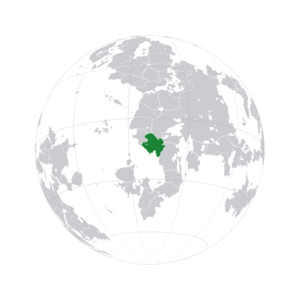Riojania: Difference between revisions
Mokkachino (talk | contribs) No edit summary |
Mokkachino (talk | contribs) |
||
| (4 intermediate revisions by the same user not shown) | |||
| Line 1: | Line 1: | ||
{{Infobox country | {{Infobox country | ||
|conventional_long_name = The State of Riojania | | conventional_long_name = The State of Riojania | ||
|native_name = | | native_name = El Estado de Riojania | ||
|common_name = | | common_name = Riojania | ||
|image_flag = | | image_flag = [[File:New Flag of riojania.png|125px]] | ||
|image_coat = | | image_coat = [[File:New Seal of riojania.png|100px]] | ||
|symbol_type = | | symbol_type = National Seal | ||
|national_motto = | | national_motto = "Hijos del Cerro" | ||
|national_anthem = | | national_anthem = "Bajo el Quebrachal" | ||
|image_map = | | image_map = [[File:Globe Map of riojania.png|thumb]] | ||
|map_caption = | | map_caption = Riojania on a Globe | ||
|capital = | | capital = [[Vinchina]] | ||
|largest_settlement = Vinchina | | largest_settlement = [[Vinchina]] | ||
|official_languages = | | official_languages = Lunfardo, Quechua and Riojano | ||
|ethnic_groups = | | ethnic_groups = Riojano and Quechua | ||
|religion = | | religion = Inti | ||
|demonym = | | demonym = Riojano/a | ||
|government_type = | | government_type = Anocracy | ||
|legislature = | | legislature = Riojano National Assembly | ||
|sovereignty_type = | | sovereignty_type = Independent State | ||
|established_event1 = | | established_event1 = | ||
|established_date1 = | | established_date1 = | ||
|established_event2 = | | established_event2 = | ||
|established_date2 = | | established_date2 = | ||
|established_event3 = | | established_event3 = | ||
|established_date3 = | | established_date3 = | ||
|established_event4 = | | established_event4 = | ||
|established_date4 = | | established_date4 = | ||
|established_event5 = | | established_event5 = | ||
|established_date5 = | | established_date5 = | ||
|established_event6 = | | established_event6 = | ||
|established_date6 = | | established_date6 = | ||
|established_event7 = | | established_event7 = | ||
|established_date7 = | | established_date7 = | ||
|established_event8 = | | established_event8 = | ||
|established_date8 = | | established_date8 = | ||
|area_km2 = | | area_km2 = 928,223 | ||
|area_sq_mi = | | area_sq_mi = 358,388 | ||
|area_label = | | area_label = <!--Label under "Area" (default is "Total")--> | ||
|area_label2 = | | area_label2 = <!--Label below area_label (optional)--> | ||
|area_data2 = | | area_data2 = <!--Text after area_label2 (optional)--> | ||
|population_estimate = | | population_estimate = 77 Million | ||
|population_estimate_rank = | | population_estimate_rank = | ||
|population_density_km2 = 84.9 | | population_density_km2 = 84.9 | ||
|population_density_sq_mi = | | population_density_sq_mi = | ||
|population_density_rank = | | population_density_rank = | ||
|GDP_PPP = | | GDP_PPP = | ||
|GDP_PPP_rank = | | GDP_PPP_rank = | ||
|GDP_PPP_per_capita = | | GDP_PPP_per_capita = | ||
|GDP_PPP_per_capita_rank = | | GDP_PPP_per_capita_rank = | ||
|GDP_nominal = | | GDP_nominal = | ||
|GDP_nominal_rank = | | GDP_nominal_rank = | ||
|GDP_nominal_per_capita = | | GDP_nominal_per_capita = | ||
|GDP_nominal_per_capita_rank = | | GDP_nominal_per_capita_rank = | ||
|Gini = | | Gini = 31.70 | ||
|HDI = | | HDI = | ||
|HDI_change = | | HDI_change = | ||
|HDI_rank = | | HDI_rank = | ||
|HDI_ref = <!--(for any ref/s to associate with HDI number)--> | | HDI_ref = <!--(for any ref/s to associate with HDI number)--> | ||
|currency = | | currency = Riojano Peso | ||
|currency_code = | | currency_code = RPE | ||
|time_zone = | | time_zone = UTC -5 | ||
|antipodes = | | antipodes = | ||
|date_format = | | date_format = DD-MM-YYYY | ||
|drives_on = | | drives_on = right | ||
|cctld = | | cctld = .ro | ||
|iso3166code = | | iso3166code = RO | ||
|calling_code = | | calling_code = | ||
}} | }} | ||
'''Riojania''', officially '''The State of Riojania''' (Spanish: El Estado de Riojania), is an independent state located on [[Olivacia]]. It shares borders with [[ | '''Riojania''', officially '''The State of Riojania''' (Spanish: El Estado de Riojania), is an independent state located on [[Olivacia]]. It shares borders with [[Horokoshi]] to the north; [[Anáhuac]] to the east; [[Kathricore]] to the west and the [[Sunadic ocean]] to the south. Riojanos form the vast majority of the nation's population and Quechua are the largest minority. [[Vinchina]] is Riojania's capital city and financial centre, while [[Petaluma]] is its central cultural and historical capital city. | ||
=Etymology= | =Etymology= | ||
The etymology of the toponym "Riojania" can be traced back to the Canterian language, with roots embedded in historical significance. The term "Rioja" is a composite of two Canterian words: "rio," signifying "river," and the suffix "-ja," commonly employed in the region to indicate specific places or locations. Consequently, the translation of "Riojania" can be construed as "The Riverlands" or "The Lands by the River." | |||
=History= | =History= | ||
===== Pre-Colonial Era ===== | |||
For thousands of years, the lands of modern Riojania were inhabited by [[Indigenous peoples of Riojania|various indigenous peoples]], most notably the [[Pachenquan Empire]] and the [[Inti-milani civilization]]. The Pachenquans established a complex society with a strong emphasis on astronomy, agriculture, and religion, worshiping [[Inti]], the sun deity. | |||
===== Colonial Period (1526–1811) ===== | |||
In 1526, explorers from the [[Canterian Empire]] arrived. Rather than eradicating the indigenous populations, the Canterians mingled and fused their culture with that of the Quechua. By 1608, the [[Viceroyalty of Petaluma]] was established, becoming a significant administrative center for the Canterian colonies. | |||
===== Independence and Civil Wars (1811–1869) ===== | |||
Following a failed invasion by the [[Riamese Empire]] in 1811, the Viceroyalty declared independence. The ensuing war also led to the independence of [[Anillaco]]. However, Riojania’s early years were tumultuous, with [[Riojano Civil Wars|11 civil wars]] between [[Riojano Federalists|Federalists]] and [[Riojano Unitarians|Unitarians]], culminating in 1869 with the victory of the Unitarians. | |||
===== The First Republic (1900–1933) ===== | |||
The '''Century Revolution''' of 1900 established Riojania’s first democratic government. This period saw significant economic and cultural growth until 1933, when the [[Popular Revolution]] brought [[Juan Federico Rodolfo Alvear|Juan Alvear]] to power. Alvear, a beloved leader, founded the ideology of [[Alvearism]], which shaped the nation’s future. | |||
===== The Foul Years (1941–1952) ===== | |||
After Juan Alvear’s death, his wife [[Isabel Catarina Alvear|Isabel Alvear]] assumed leadership but became a puppet of the authoritarian [[Ignacio Raveliño]]. Raveliño’s regime, known as the [[Foul Years]], was marked by severe oppression, human rights abuses, and clandestine fascist policies. His mysterious death in 1951, followed by the military’s intervention, led to the establishment of the Second Republic in 1953. | |||
===== Modern Era (1953–2025) ===== | |||
The Second Republic eventually evolved into an [https://en.wikipedia.org/wiki/Anocracy?useskin=vector Anocracy] in 1967, marking the start of the [[Third Alvearist Period]]. The ruling [[Unión Cívica Nacional]] has maintained dominance through manipulated elections. Despite this, Riojania remains a regional power with a thriving economy and influential [[Riojano Military Defense Forces|military]]. | |||
=Government & Politics= | =Government & Politics= | ||
Latest revision as of 05:42, 23 January 2025
The State of Riojania El Estado de Riojania | |
|---|---|
| Motto: "Hijos del Cerro" | |
| Anthem: "Bajo el Quebrachal" | |
Riojania on a Globe | |
| Capital and largest city | Vinchina |
| Official languages | Lunfardo, Quechua and Riojano |
| Ethnic groups | Riojano and Quechua |
| Religion | Inti |
| Demonym(s) | Riojano/a |
| Government | Anocracy |
| Legislature | Riojano National Assembly |
| Independent State | |
| Area | |
• | 928,223 km2 (358,389 sq mi) |
| Population | |
• Estimate | 77 Million |
• Density | 84.9/km2 (219.9/sq mi) |
| Gini | 31.70 medium |
| Currency | Riojano Peso (RPE) |
| Time zone | UTC -5 |
| Date format | DD-MM-YYYY |
| Driving side | right |
| ISO 3166 code | RO |
| Internet TLD | .ro |
Riojania, officially The State of Riojania (Spanish: El Estado de Riojania), is an independent state located on Olivacia. It shares borders with Horokoshi to the north; Anáhuac to the east; Kathricore to the west and the Sunadic ocean to the south. Riojanos form the vast majority of the nation's population and Quechua are the largest minority. Vinchina is Riojania's capital city and financial centre, while Petaluma is its central cultural and historical capital city.
Etymology
The etymology of the toponym "Riojania" can be traced back to the Canterian language, with roots embedded in historical significance. The term "Rioja" is a composite of two Canterian words: "rio," signifying "river," and the suffix "-ja," commonly employed in the region to indicate specific places or locations. Consequently, the translation of "Riojania" can be construed as "The Riverlands" or "The Lands by the River."
History
Pre-Colonial Era
For thousands of years, the lands of modern Riojania were inhabited by various indigenous peoples, most notably the Pachenquan Empire and the Inti-milani civilization. The Pachenquans established a complex society with a strong emphasis on astronomy, agriculture, and religion, worshiping Inti, the sun deity.
Colonial Period (1526–1811)
In 1526, explorers from the Canterian Empire arrived. Rather than eradicating the indigenous populations, the Canterians mingled and fused their culture with that of the Quechua. By 1608, the Viceroyalty of Petaluma was established, becoming a significant administrative center for the Canterian colonies.
Independence and Civil Wars (1811–1869)
Following a failed invasion by the Riamese Empire in 1811, the Viceroyalty declared independence. The ensuing war also led to the independence of Anillaco. However, Riojania’s early years were tumultuous, with 11 civil wars between Federalists and Unitarians, culminating in 1869 with the victory of the Unitarians.
The First Republic (1900–1933)
The Century Revolution of 1900 established Riojania’s first democratic government. This period saw significant economic and cultural growth until 1933, when the Popular Revolution brought Juan Alvear to power. Alvear, a beloved leader, founded the ideology of Alvearism, which shaped the nation’s future.
The Foul Years (1941–1952)
After Juan Alvear’s death, his wife Isabel Alvear assumed leadership but became a puppet of the authoritarian Ignacio Raveliño. Raveliño’s regime, known as the Foul Years, was marked by severe oppression, human rights abuses, and clandestine fascist policies. His mysterious death in 1951, followed by the military’s intervention, led to the establishment of the Second Republic in 1953.
Modern Era (1953–2025)
The Second Republic eventually evolved into an Anocracy in 1967, marking the start of the Third Alvearist Period. The ruling Unión Cívica Nacional has maintained dominance through manipulated elections. Despite this, Riojania remains a regional power with a thriving economy and influential military.
Government & Politics
Administrative Regions
Foreign Relations
Military
Law
Geography
Economy
Demographics
Culture


